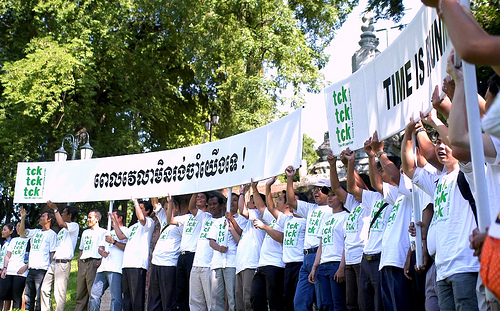
សម្លេងពីកម្ពុជា–ពេលវេលាមិនរង់ចាំយើងទេ។ រូបភាព ថតដោយ Oxfam International, ២១ តុលា ២០០៩។ ក្រោមអាជ្ញាប័ណ្ណ CC BY-NC-ND 2.0។
ការប្រែប្រួលអាកាសធាតុ ត្រូវបានផ្តល់និយមន័យថា ជាការបកស្រាយយោងទៅតាមស្ថិតិស្តីអំពីលំនាំ អាកាសធាតុដែលមានការប្រែប្រួលក្នុងរយៈពេលវែងមួយ។ ខណៈពេលអាកាសធាតុនៅលើផែនដីបានឆ្លងកាត់អំឡុងពេលនៃការប្រែប្រួល ភ័ស្តុតាងតាមបែបវិទ្យាសាស្ត្រសម័យទំនើបបានបង្ហាញថា ការកើនឡើងនិងបំរែបំរួលធាតុអាកាសដ៏ឆាប់រហ័ស កំពុងតែកើតមានឡើងនៅទូទាំងពិភពលោក ហើយវាត្រូវបានហៅថា “ការប្រែប្រួលអាកាសធាតុ” ដែលជាលទ្ធផលកើតចេញពីសកម្មភាពរបស់មនុស្សទាក់ទងទៅនឹងការធ្វើឧស្សាហូបនីយកម្ម ការកាប់បំផ្លាញព្រៃឈើ និងបម្រែបម្រួលនៃការប្រើប្រាស់ដី។1
ប្រទេសកម្ពុជា ស្ថិតក្នុងចំណាត់ថ្នាក់ជាប្រទេសមួយក្នុងបណ្តាប្រទេសដែលងាយរងគ្រោះបំផុត ពីការប្រែប្រួលអាកាសធាតុ នៅក្នុងតំបន់អាស៊ីអាគ្នេយ៍។2 របាយការណ៍គម្របព្រៃឈើឆ្នាំ២០១៤ ដែលចេញផ្សាយដោយអង្គការទិន្នន័យអំពីការអភិវឌ្ឍ(ODC) បានបង្ហាញពីនិន្នាការដែលកំពុងកើតមានក្នុងការបាត់បង់គម្របព្រៃឈើ ជាពិសេសព្រៃស្រោងនៅទូទាំងប្រទេសកម្ពុជា ចាប់តាំងពីឆ្នាំ១៩៧៣មក។3 ជាលើកដំបូងហើយ ក្នុងរយៈពេល ៤១ ឆ្នាំកន្លងមក ដែលភាគរយនៃគម្របផ្ទៃដីមិនមែនព្រៃ (៤៨.៤ ភាគរយ) មានទំហំធំជាងគម្របព្រៃឈើ (៤៧.៧ ភាគរយ)។4 គួរបញ្ជាក់ផងដែរថា ការកាប់បំផ្លាញព្រៃឈើដែលមានអត្រាខ្ពស់នឹងរួមចំណែកដល់ការបំភាយឧស្ម័នផ្ទះកញ្ចក់។
ប្រទេសកម្ពុជា ងាយទទួលរងផលប៉ះពាល់ខ្លាំងពីការប្រែប្រួលអាកាសធាតុ ដោយសារកម្ពុជា ពឹងផ្អែកខ្លាំងលើវិស័យនានាដែលពាក់ព័ន្ធទៅនឹងធាតុអាកាស ដូចជា វិស័យកសិកម្ម ដីធ្លី ធនធានទឹក ព្រៃឈើ និងជលផលជាដើម។5 ដោយសារកម្ពុជា ជាប្រទេសកំពុងអភិវឌ្ឍន៍ ជាមួយនឹងលទ្ធភាពឆ្លើយតបនឹងបំរែបំរួលអាកាសធាតុនៅទន់ខ្សោយ ព្រមទាំងហេដ្ឋារចនាសម្ព័ន្ធនៅមានកម្រិតនៅឡើយ ហេតុនេះជីវភាពរស់នៅរបស់ប្រជាជននៅតាមជនបទ ជាពិសេសស្ត្រី និងក្រុមងាយរងគ្រោះដទៃទៀត នឹងមានឧបសគ្គក្នុងការដោះស្រាយបញ្ហាផលប៉ះពាល់នៃការប្រែប្រួលអាកាសធាតុ។6
យោងតាម ការសិក្សាតាមបែបវិភាគមួយ របស់ទីភ្នាក់ងារសហរដ្ឋអាមេរិកសម្រាប់ការអភិវឌ្ឍអន្តរជាតិ (USAID) ដែលបានអនុវត្តការព្យាករអាកាសធាតុសម្រាប់ឆ្នាំ២០៥០ ចំពោះសេដ្ឋកិច្ចនៅតំបន់អាងទន្លេមេគង្គនាពេលបច្ចុប្បន្ននេះ បង្ហាញឲ្យឃើញពីការខាតបង់សេដ្ឋកិច្ច ដោយសារការប្រែប្រួលអាកាសធាតុនាពេលអនាគត អាចនឹងកើនរហូតដល់ទៅ ៦១ភាគរយ នៃផលិតផលក្នុងស្រុកសរុបនៅតាមទីជនបទ ក្នុងមនុស្សម្នាក់នៅប្រទេសកម្ពុជា។7 គួរកត់សម្គាល់ផងដែរថា ការព្យាករអាកាសធាតុឆ្នាំ២០៥០ នឹងប៉ះពាល់ប្រជាជនកម្ពុជា ប្រមាណ៧លាននាក់ ដែលប្រកបមុខរបរក្នុងវិស័យកសិកម្ម និង ប្រមាណ ២៤០,០០០ នាក់ នៅក្នុងវិស័យសំណង់ ដែលបង្កឱ្យមានផលប៉ះពាល់សេដ្ឋកិច្ចសរុបប្រមាណ ១.៥ ពាន់លានដុល្លារសហរដ្ឋអាមេរិក។8
រាជរដ្ឋាភិបាលកម្ពុជា បានព្យាករណ៍ថា សីតុណ្ហភាពប្រចាំខែជាមធ្យម នឹងកើនឡើងចន្លោះពី ០.០១៣ អង្សាសេ និងកើនឡើង ០.០៣៦ អង្សាសេក្នុងមួយឆ្នាំ នៅឆ្នាំ២០៩៩។9
របាយការណ៍វិភាគអំពីការខូចខាត និងការបាត់បង់ដោយសារគ្រោះមហន្តរាយនៅកម្ពុជា បង្ហាញថា ទឹកជំនន់ប្រមាណ ៤២ភាគរយ, គ្រោះរាំងស្ងួត ១៥ភាគរយ, អគ្គីភ័យ ១៧ភាគរយ, ខ្យល់ព្យុះ ១៤ភាគរយ, រន្ទះបាញ់ ៧ភាគរយ និងការរាតត្បាតកត្តាសត្វចង្រៃ ១ភាគរយ បានកើតឡើងនៅក្នុងប្រទេសកម្ពុជា ពីឆ្នាំ១៩៩៦ ដល់ឆ្នាំ២០១៣។10 គួរឱ្យកត់សម្គាល់ផងដែរថា ក្នុងកំឡុងពេលនេះ គ្រោះមហន្តរាយ បានសម្លាប់មនុស្សចំនួន ២,០៥០ នាក់ ហើយការស្លាប់ដោយសារទឹកជំនន់មានប្រមាណ ៥៣ ភាគរយ នៃទិន្នន័យសរុប។11
ហេតុដូច្នេះហើយ រាជរដ្ឋាភិបាលកម្ពុជា មានគោលនយោបាយ និងយុទ្ធសាស្ត្រ ក្នុងការធានាឱ្យបាននូវការអភិវឌ្ឍសេដ្ឋកិច្ចសង្គម និងការអភិវឌ្ឍប្រកបដោយនិរន្តរភាពក្នុងបរិបទការប្រែប្រួលអាកាសធាតុ។ គោលនយោបាយឆ្លងវិស័យ ដែលពាក់ព័ន្ធទៅនឹងការប្រែប្រួលអាកាសធាតុនៅកម្ពុជា រួមមាន៖
- ផែនការយុទ្ធសាស្ត្រអភិវឌ្ឍន៍ជាតិឆ្នាំ ២០១៤-២០១៨
- ផែនការយុទ្ធសាស្រ្តការប្រែប្រួលអាកាសធាតុឆ្នាំ ២០១៤-២០២៣
- គោលនយោបាយកំណើនបៃតងឆ្នាំ ២០១៣-២០៣០
- ផែនការសកម្មភាពជាតិបន្ស៊ាំទៅនឹងការប្រែប្រួលអាកាសធាតុ ឆ្នាំ២០០៦
- ផែនទីចង្អុលផ្លូវកំណើនបៃតងថ្នាក់ជាតិ ឆ្នាំ២០០៩
- ផែនការសកម្មភាពជាតិយុទ្ធសាស្រ្តសម្រាប់ការកាត់បន្ថយហានិភ័យនៃគ្រោះមហន្តរាយ ២០០៨-២០១៣
- យុទ្ធសាស្រ្តជាតិគាំពារសង្គមសម្រាប់ជនក្រីក្រ និងជនងាយរងគ្រោះ ឆ្នាំ២០១១
បានធ្វើបច្ចុប្បន្នភាព៖ ៣០ វិច្ឆិកា ឆ្នាំ២០១៥
ទាក់ទងនឹង ការប្រែប្រួលអាកាសធាតុ
- គ្រោះមហន្តរាយ និងការឆ្លើយតបក្នុងគ្រាអាសន្ន
- ការកាត់បន្ថយការប្រែប្រួលអាកាសធាតុ
- ការបំពុល និងសំណល់
- គម្របព្រៃឈើ
ឯកសារយោង
- 1. របាយការណ៍អភិវឌ្ឍន៍មនុស្សកម្ពុជាឆ្នាំ២០១១, ការកសាងភាពធន់៖ អនាគតរបស់អ្នកជនបទក្នុងការប្រឈមមុខនឹងការប្រែប្រួលអាកាសធាតុ. ក្រសួងបរិស្ថាន និងអង្គការ UNDP កម្ពុជា, ២០១១.
- 2. Arief A. Yusuf, Herminia A. Francisco.ការវិភាគផែនទី. ការកំណត់ផែនទីភាពងាយរងគ្រោះនៃការប្រែប្រួលអាកាសធាតុចំពោះតំបន់អាស៊ីអាគ្នេយ៍. EEPSEA: ២០០៩. ដកស្រង់ ៥ ខែ ឧសភា ២០១៥. http://www.eepsea.org/pub/tr/12324196651Mapping_Report.pdf
- 3. “គម្របព្រៃឈើ.” អង្គការទិន្នន័យអំពីការអភិវឌ្ឍ. ១០ មេសា ២០១៥. ដកស្រង់ ៥ ឧសភា ២០១៥. http://www.opendevelopmentcambodia.net/briefing/forest-cover/.
- 4. ដូចលេខយោងខាងលើ
- 5. ក្រសួងបរិស្ថាន. ឯកសារគោលនយោបាយ. ផែនការយុទ្ធសាស្ត្រស្តីពីការប្រែប្រួលអាកាសធាតុនៅកម្ពុជា ២០១៤-២០២៣. ក្រសួងបរិស្ថាន៖ ២០១៤. ដកស្រង់ ៥ ឧសភា ២០១៥. http://www.camclimate.org.kh/en/documents-and-media/library/category/127-national-strategic-plan.html?download=474:cambodia-climate-change-strategic-plan-2014-2023-en-final.
- 6. ណង ភិរុណ. ការបន្ស៊ាំការប្រែប្រួលអាកាសធាតុនិងការចិញ្ចឹមជីវិតក្នុងការលើកកម្ពស់កំណើនសេដ្ឋកិច្ច៖ ការពិនិត្យឡើងវិញនៃផលប៉ះពាល់ការប្រែប្រួលអាកាសធាតុនិងការកសាងសមត្ថភាពបន្សាំនៅកម្ពុជា. CDRI៖ ២០១៣. ដកស្រង់ ៤ ឧសភា ២០១៥. https://cdri.org.kh/wp-content/uploads/wp82e.pdf
- 7. Talberth, John. Reytar, Katie. ការប្រែប្រួលអាកាសធាតុនៅតំបន់អាងទន្លេមេគង្គក្រោម. ញូវយ៉ក៖ ទីភ្នាក់ងារសហរដ្ឋអាមេរិកសម្រាប់ការអភិវឌ្ឍអន្តរជាតិ (USAID), ២០១៤. ដកស្រង់ ៧ ឧសភា ២០១៥. http://mekongarcc.net/sites/default/files/usaid_marcc_values_at_risk_report_with_exesum-revised.pdf
- 8. ដូចលេខយោងខាងលើ
- 9. ក្រសួងបរិស្ថាន. ឯកសារគោលនយោបាយ. ផែនការយុទ្ធសាស្ត្រស្តីពីការប្រែប្រួលអាកាសធាតុនៅកម្ពុជា ២០១៤-២០២៣. ក្រសួងបរិស្ថាន៖ ២០១៤. ដកស្រង់ ៥ ឧសភា ២០១៥. http://www.camclimate.org.kh/en/documents-and-media/library/category/127-national-strategic-plan.html?download=474:cambodia-climate-change-strategic-plan-2014-2023-en-final.
- 10. គណៈកម្មាធិការជាតិគ្រប់គ្រងគ្រោះមហន្តរាយ និងកម្មវិធីអភិវឌ្ឍន៍អង្គការសហប្រជាជាតិនៅកម្ពុជា. របាយការណ៍វិភាគ. របាយការណ៍វិភាគការខូចខាតនិងការបាត់បង់ដោយសារគ្រោះមហន្តរាយនៅកម្ពុជា ១៩៩៦-២០១៣. ដកស្រង់ ៧ ឧសភា ២០១៥. http://www.kh.undp.org/content/dam/cambodia/docs/EnvEnergy/Cambodia-Disaster-Loss-and-Damage-Analysis-Report%201996-%202013.pdf.
- 11. ដូចលេខយោងខាងលើ

